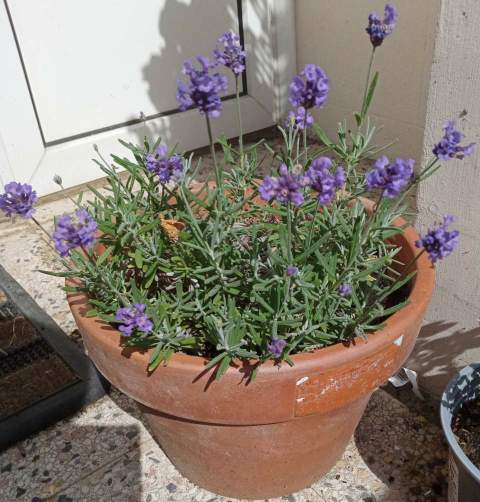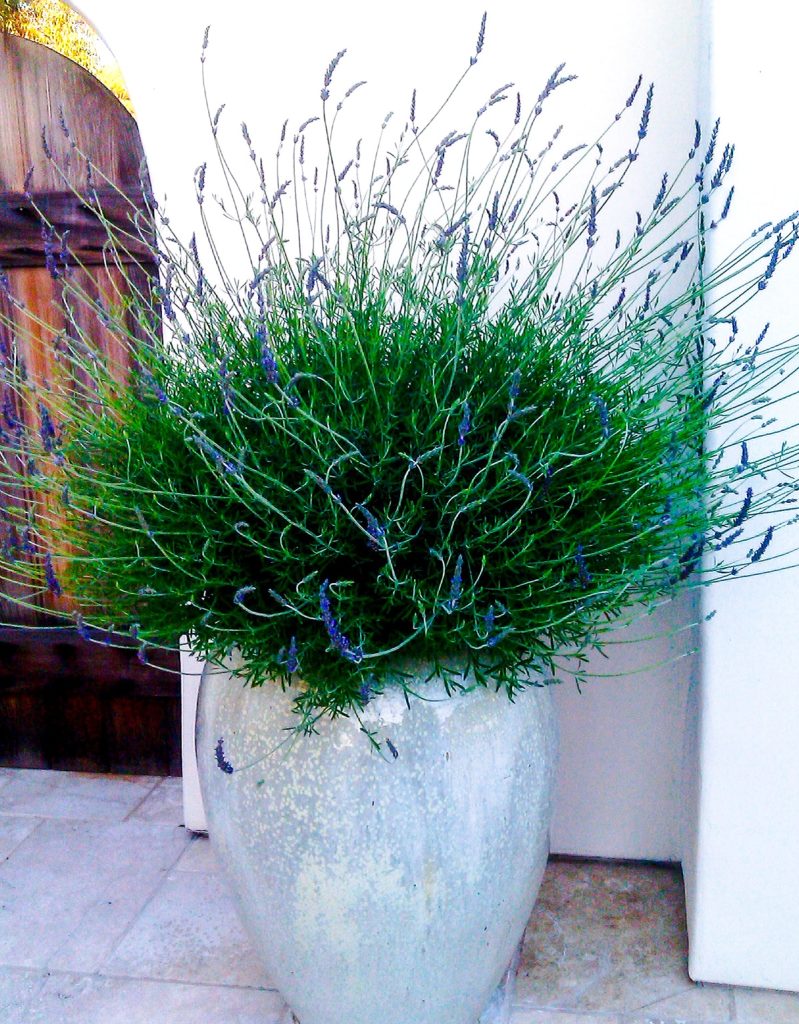
All kinds of lavender thrive in containers, but there are a few factors to take into account while selecting the ideal container for lavender growth.
To make sure that your lavender flourishes and produces its delightful perfume and display of flowers, keep each of these factors in mind.
Table of Contents
Best Pot Size for Growing Lavenders
Lavenders come in a variety of sizes. Hidcote Superior, for example, matures to a modest size of approximately 16 by 18 inches (40 to 45 cm), whilst Vera, a larger cultivar, matures to a size of 30 to 36 inches (75 to 90 cm).
Regardless of the size of the lavender, I would advise planting it in pots that are at least 12 to 16 inches across and the same proportionate depth.
This is due to the fact that the pot must be large enough to hold enough soil for the lavender’s roots to remain protected from the cold and to prevent the soil from drying out too soon if there has been continuous intense sunlight.
All types of lavender thrive in pots because they drain much more quickly than most soils do, and because lavenders need their roots to remain mostly dry to prevent root rot.
However, the container will raise the roots above the earth (in contrast to lavender planted in a garden), making them more vulnerable to high temperatures.
Lavenders require full sun to flower at their finest, but this will also speed up the rate at which water evaporation from the soil, making it crucial to have a good-sized pot with enough soil capacity so that it does not dry out as rapidly as a small pot would.
Too-small pots might cause the soil to bake hard, which is bad for the roots of the lavender plant.
Similarly, throughout the winter, the earth insulates the roots of the lavender plants. Although the Lavandula angustifolia species of English lavender is cold hardy and can withstand frost, a good-sized pot with lots of soil will assist protect roots from the worst of the cold.
By doing this, you’ll enhance the likelihood that your lavender plant will survive the winter and retain a strong, fragrant plant that flowers well (read my article for more on caring for lavenders in winter).
Keep in mind that it is simple to move lavender (the best time to do this is early spring) into another pot, but for the best practices, I suggest reading my post on how to properly move lavenders.
Best Material for Lavender Pots
I’ve observed lavenders flourishing in fashionable containers made of metal, wood, plastic, and terracotta.
In contrast, I’ve discovered that metal pots and containers, particularly the thinner plastic pots, have a tendency to heat up more in the sun and absorb all the heat.
As a result, the roots and soil will become warmer. Since lavenders are drought-tolerant plants that are native to Europe’s hot and arid Mediterranean region, they can thrive successfully in metal and plastic containers.
However, if the pot is exposed to heat all day, the soil will dry out much more quickly, necessitating more frequent watering.
During the growing season, established lavender plants only require one watering every two weeks (unless there has been a substantial amount of rainfall). You might need to raise this to once every 10 days and check the soil moisture frequently if you’re using metal or plastic pots.
Because they don’t tolerate a lot of water, watering lavenders can be hard because the symptoms of overwatering and underwatering are deceptively similar. Check out my article on how to water lavenders in pots for more details on how to strike the proper balance.
The ceramic or terracotta style pots are personally my favorite containers for planting lavender. Compared to metal or wood, these pots are much more resistant to the elements and weather.
The planters made of ceramic or terracotta are often much thicker than those made of metal or plastic. As a result, they won’t bake as quickly or dry out as quickly in the summer, and they will resist frost a little bit better in the winter.
I always advise using a good-sized ceramic or terracotta pot for growing lavender for the best results, but keep in mind that these pots will be heavier than metal or plastic ones.
If you live in a region with winter frosts, the French and Spanish types of lavender may need to be moved indoors for protection over the winter. They are not as cold tolerant as English lavenders.
This can be challenging with large ceramic pots, so if you have to transfer pots indoors and out on a yearly basis, a lighter, more maneuverable pot made of plastic would be preferable.
Since English lavenders are frost-tolerant and cold-hardy, you won’t need to move the pots every winter. They can be left outside all year.
(For all the recommended maintenance procedures, read my post on how to cultivate lavenders in pots.)
Good Drainage in the Base of the Pot

Additionally, I would want to underline how crucial it is to keep the drainage holes as clear as possible. Spreading a layer of pebbles measuring 1 inch thick on the bottom of the pot is a good technique to do this. This will guarantee that the design permits extra water to drain easily from the base of the pot without being blocked by compacted dirt.
Place the plant on decorative “feet” or small supports as an additional precaution. This will raise the pot off the ground so that water can drain away rather than pool at the bottom, giving your lavender plants’ roots a chance to partially dry out in between watering sessions.
Do not make this error!
When it comes to potted lavender, another error I notice is choosing the right sort of pot with drainage holes but setting the plant in a tray or other container to capture the runoff water. People frequently do this to stop water leaks and maintain the dryness of their patio.
However, lavender like soaking and drying, where they get a lot of water every two weeks. The plant will become healthier and more drought-resistant as a result of being encouraged to grow roots.
Water will inevitably have to flow out of the pot’s base. If the water is collected in a tray, the soil will be continuously moister than it needs to be to grow lavenders well.
Key Takeaways:
- The ideal pot size for growing lavenders is 16 inches across, manufactured of ceramic or terracotta. The pot’s base must include drainage holes so that the lavender roots can dry out in between waterings.
- A good-sized pot has enough soil in it to minimize soil evaporation in the summer heat and to insulate the roots of the lavender plant during the winter.
- Metal or plastic pots, which are relatively light and can be moved around much more easily, can be used to grow lavender plants. Although they can be significantly heavier, terracotta and ceramic pots offer the roots greater protection from the elements and they do not dry out as rapidly in the sun.
- In order to prevent root rot in lavender plants, do not use trays that collect water underneath your pot.
- In order to prevent obstructions (like compacted dirt) from obstructing the drainage of surplus water, it is ideal to cover the drainage holes with a layer of gravel.
FAQ
Does lavender do better in pots or ground?
Full light and proper drainage are essential for lavender. In the winter, it is more likely to die from too much moisture than from the cold. Although the plant will be more susceptible to cold temperatures than it would be in the ground, a container is a great way to promote drainage.
Does lavender like being in pots?
Lavender grows quite well in containers. It really grows better in pots in the Deep South because of the enhanced drainage and airflow. Although the plants flourish in the dry conditions of the West, they are typically regarded as annuals in the South.
How deep do pots need to be for lavender?
12 to 16 inches
Do lavender plants need big pots?
A large pot will allow for this growth since lavender plants can get as big as a small shrub. The container sizes you should look for are 12 to 16 inches. Avoid looking at a pot that has a saucer connected because this will prevent effective draining.
